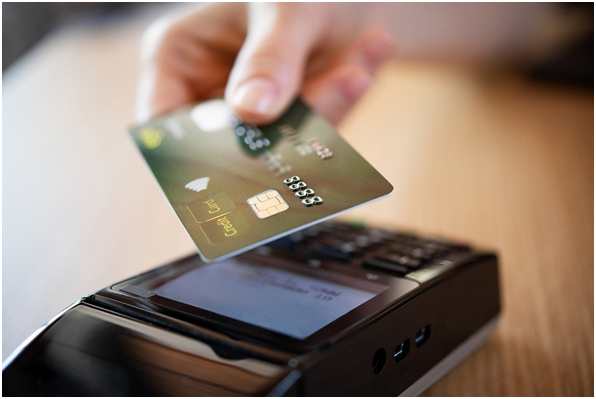The Advantages of Contactless Payments for Businesses

Contactless payments are here to stay, but while they are growing in popularity among businesses and consumers alike, many are still wondering if contactless is really the future. As expert POS system providers, we’re here to break down the basics and elaborate on the clear benefits contactless payments can offer your business.
What is a contactless transaction?
Simply put, a contactless transaction is made when a person waves their credit card or smartphone above a credit card terminal in a store, and the payment is automatically registered by the system. This instant transaction means there is no need to swipe or insert your chip and enter passwords to complete your purchase.
What are the advantages of contactless payments?
Contactless payments are not a new phenomenon, in fact, they have been around for over two decades already! They offer a wide range of benefits that both business owners and consumers alike can use and profit from. Below, we list six of the top advantages of contactless payments.
1. Convenience
Contactless payments combine security and speed, so transactions can happen efficiently in a matter of seconds. The convenience of this means that waiting times in long lines are drastically reduced. Your business can avoid long-waiting queues, process more transactions in a day, and increase profit in the long run.
These easy payments are completed using NFC (near field communication) technology which sends radio frequencies that allow wireless communication to pass between cards and POS devices. This fast efficiency can help businesses remove friction during transactions as less time is spent counting change, swiping cards, or pressing buttons. Basically, contactless payments are the most hassle-free payment solutions for businesses to invest in – they can even choose to email receipts to customers to create less paper waste.
2. Safety
Having hygiene safety measures in place is vital for every business, especially during times such as these when a pandemic is a worldwide concern. For many businesses, sanitising every EFTPOS terminal between uses isn’t possible. However, germs can build up and be easily transferred during these transactions. When it comes to contactless payments in comparison, they involve minimal risk because each customer only needs their card or mobile device to complete a transaction. The risk of transferring germs is significantly reduced because customers can make their payment wirelessly without ever needing to touch the terminal or PIN pad.
3. Security
One of the biggest concerns people have with contactless payments is that they are worried about the security of their device. If their card were stolen, it could be used without the need for a PIN or ZIP code. However, most wireless payments have certain measures and spending limits put in place for this reason (either by the bank or the card holder), so that only small transactions can take place without the use of a PIN.
On top of this, contactless payments offer a level of protection that traditional magnetic stripe cards do not. While magnetic card types transmit the cardholders name, security code, and billing information with each purchase (which can be copied), a contactless purchase is made with a one-time encryption code which is transmitted from the credit card to the reader.
4. No additional fees
Contactless payments also require no additional fees from businesses or consumers which means there is no real downside for businesses to invest in wireless payment solutions. Businesses and consumers alike can expect to pay the same fees they would pay with regular credit card transactions. The only difference is that businesses can cater to a wider range of payment preferences.
5. Increased customer satisfaction
Customer satisfaction is at the forefront of importance for every business. Because of hygiene safety, security, and efficiency aspects of contactless transactions, businesses can provide an overall happier customer experience for their clients and therefore reach higher levels of customer satisfaction. This type of transaction can be particularly beneficial for industries where face-to-face interaction is part of everyday proceedings (e.g. restaurants, bars, and convenience stores).
6. Improved loyalty programs
While many businesses provide loyalty programs for their customers, with contactless payments, they can take them online. A digital loyalty program will not only reward customers for making contactless payments, customers will also have easy access to digital copies of their reward, loyalty, membership, and gift cards, as well as to special deals (i.e. coupons, promotions, and rebates) that you have on offer.
What this means for businesses in 2020 onwards
As social distancing is becoming a part of normal everyday life, wireless EFTPOS payments continue to increase in popularity and are becoming the preferred payment method for many consumers worldwide. This is evident in various online analysis, for example, during the first quarter of 2020, Mastercard reported a 40% jump in contactless payments from shoppers fearful of germs transferred via cash and credit cards. In comparison, over the last 18 months contactless visa transactions tripled in Hong Kong, and in Australia, 75% of face-to-face transactions are now performed through contactless payment methods, as well.
With this in mind, company owners looking for new ways to improve their services and increase profits should see contactless payments as an opportune way of moving their business forward.
Choose Rocket POS for safe and secure POS management solutions
So, if you’re looking for fast and efficient contactless solutions for your business, let us help you! Here at Rocket POS, we provide point-of-sale management solutions to thousands of small and large businesses New Zealand wide. Explore our range of POS management systems online, including everything from mobile EFTPOS solutions to complete POS systems, and provide your customers with the opportunity to perform contactless transactions effortlessly.

